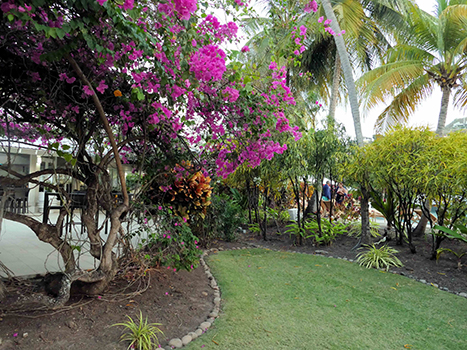
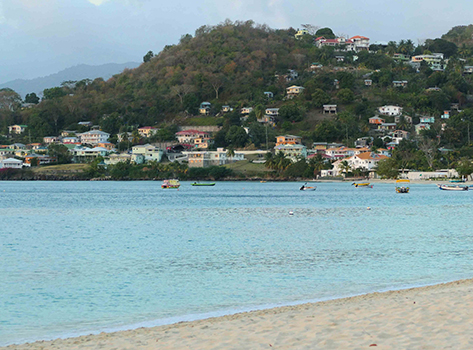
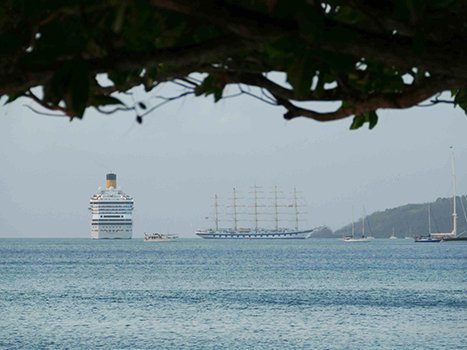
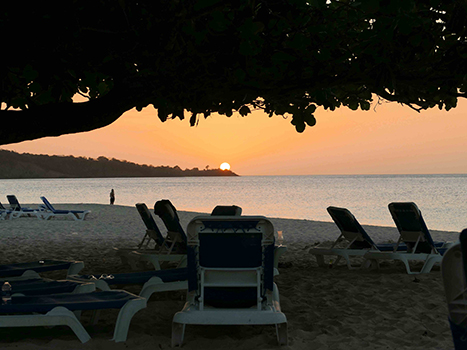
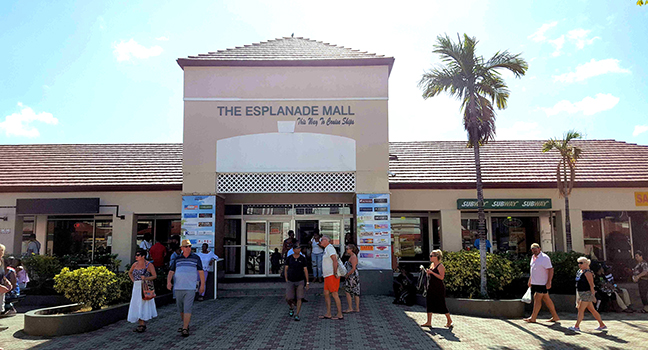

I got the idea of this trip last summer when I received a brochure from the Rice University Traveling Owls about a week-long cruise in the Caribbean on a motor yacht in March, 2019. Why not? Louise has been consistently opposed to the idea of a cruise, but she is thinking of those floating behemoths that carry thousands of passengers. This trip was restricted to no more than 60 passengers, no kids, who are members (or spouses of members) of the alumni association of certain fine universities (including Rice). Furthermore, our cruise ship was Le Ponant, a three-masted sailing vessel that only uses its motor for manoeuvering in port. How cool is that, running off the power of the wind!
Sure enough, Louise was willing to give it a try and I reserved us a cabin. On Monday, March 4, we flew to Grenada where we were to board. We got there a day early, so we could lounge around the beach instead of being worried about missing the boat. The hotel was very pleasant, the beach sandy and the scenery delightful. We did a little last-minute shopping for things we might need on the trip in St. Georges, the capital city of Grenada.
 |
 |
 |
| Hotel grounds | Across the bay from the hotel | Cruise ships |
 |
 |
 |
| Sundown on the beach | The mall | The kind rastaman who looked after our luggage |
Finally, in the afternoon of March 5, we walked to the dock and embarked. The boat was quite nicely appointed. As we entered, we walked into a large lounge that could hold all the passengers, with a bar and an area to eat casual meals - breakfast and lunch - near the stern. Down the stairs were the cabins. I had recently watched the Marx Brothers movie A Night at the Opera and was expecting something like their cabin, but in fact we had a queen bed, a refrigerator, some small closet spaces and a microscopic - but adequate - bathroom and shower. Fully air-conditioned, too, although it could only be adjusted with some difficulty. Upstairs was a fancy dining-room where we ate our fancy meals; above that was the sun deck where you could lounge around and get a sunburn.
The boat is technically a motor yacht, with three masts. With sails set, she should be able to do 15 knots, although the mailsail had been damaged in their last voyage and had been removed. The foresail was an experimental one, consisting of stiff fiberglass rectangles lying on a plate. The only time we saw it raised, it jammed at some point and needed some coaxing before it could be completely raised, so maybe the experiment was not a complete success. The mizzensail was a conventional canvas one.
The first night we stayed in port so that we could be taken around some of the sights in and around St. Georges the following day. (And so the guys who missed the boat would have a second chance.) We dined with two fellow Rice alumni association members, although it turned out that they had pretty much nothing to do with Rice university. They were sisters - one lived in Houston and signed up for the alumni association because it offered interesting things to do, including tours with the Traveling Owls. The other lived in Oregon and liked to travel with her sister. They were excellent company in any case. There were also two other genuine Rice graduates - brothers - who both now lived in Fredericksburg, Texas with their families.
While we were in the lounge, someone came up to Louise and said "Louise Lynch?" She turned out to be a neighbor from Larchmont, a member of the Dartmouth alumni association, who had a daughter who had played with Madeleine. How about that for coincidence?! But then someone else came up to Louise and said "Louise Lynch?" She had worked at PBS with Louise back when we lived in D.C. I started sniffing a plot - had Louise secretly invited everyone she knew to sign up for the cruise? She denied it, of course, but I still wondered.
The general pattern with our travels was that the boat would set its sails in the evening and take us to our next destination overnight. Then, after breakfast, we would be divided into groups that would each debark, get into a minibus and be whisked off to one or more places of interest. On the first day, our group went first to the old fort overlooking the town. Grenada was a French colony before being grabbed by the British. In 1974, it became independent and had a somwhat tumultuous path thereafter. A Marxist group siezed power in 1979 but was overthown by the military. Finally, in 1983, Ronald Reagan sent troops to restore order and expell the Marxists. In 1984, elections were held and democratic procedures have resumed. I'm not sure how everyone thinks of the U.S. invasion, although we did see a large mural thanking the U.S. for it. We also saw bullet-holes in the stone where some of the communists were executed. The outside walls were pretty solid and they were still sporting some serious (but ancient) cannon overlooking the harbor. The interior of the fort however had been largely destroyed by hurricane Ivan, which trashed the island in 2004.
The second stop on our tour was a spice farm. Grenada is known as the Spice Island and continues to be a major exporter of nice-smelling things like nutmeg. We strolled around the farm and dutifully sniffed the plants and laughed at the tour guide's jokes.
Finally, we visited a distillery. Grenada used to be a big producer of sugar cane, which it used to fuel a booming rum industry. For some reason, Grenada no longer produces sugar, but it still makes rum out of imported sugar. The tour was actually pretty interesting, starting in a part of the building that just show-cased the original technology that had not been used for years. Then we went to see the actual distillation taking place, using more modern tech. Lastly, but not leastly, we ended up in the shop where you can buy all kinds of distilled spirits.
When the day was over and Louise and I had gone to bed, the crew finally cranked up the engine and we got under weigh. They invited everyone to come up to the sun deck to watch the raising of the sails, but that didn't happen until after we were fast asleep.
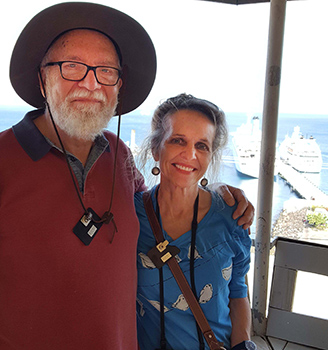 |
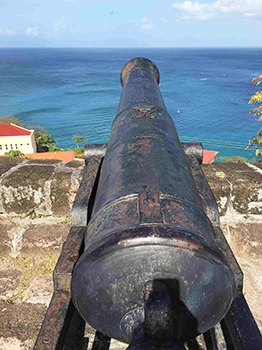 |
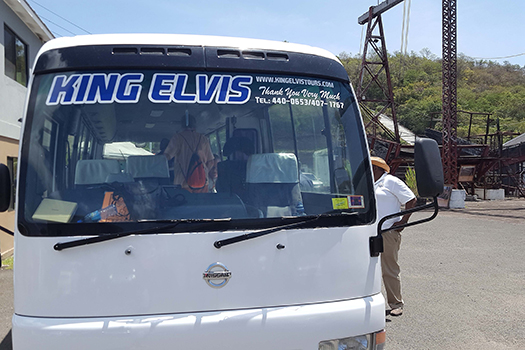 |
| Top of the Fort de France | Cannon on the fort | Our minivan |
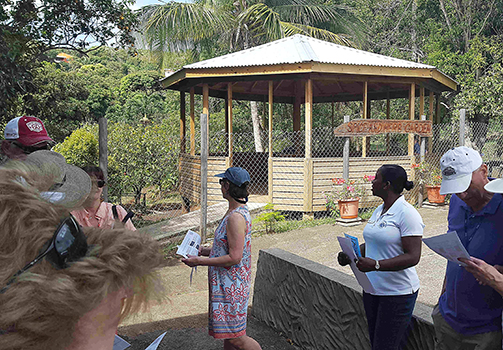 |
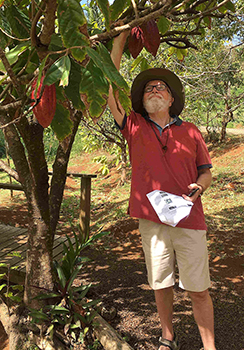 |
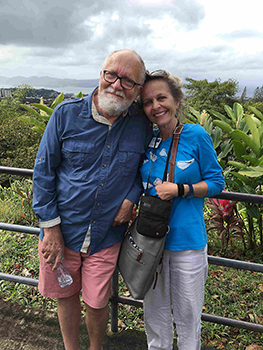 |
| Spice garden | Checking on a coconut | Us |
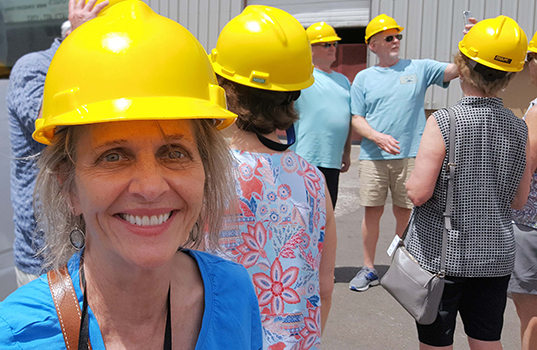 |
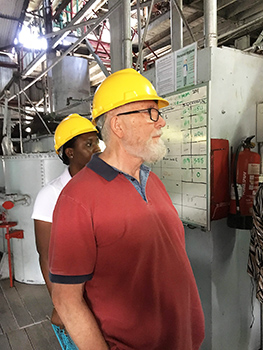 |
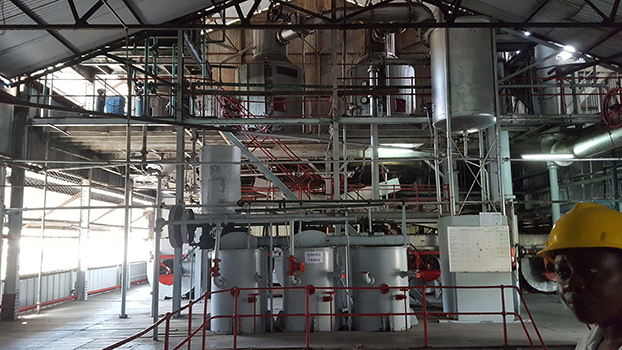 |
| Preparing for the rum distillery | The distillery |
When we awoke, we were anchored near Chatham Bay, Union Island. I had developed a nasty cough and so we just lounged about on the boat while other passengers took a Zodiac to the beach. In the afternoon, the boat moved a short distince to Mayeau, another beautiful island in the Grenadines. This time, Louise and I went with the others to the beach. There were several other large boats that had disgorged passengers on the beach, but the beach was big enough to accommodate everyone. Some people did some snorkeling while we snoozed on the beach in the shelter of a coconut palm.
The next morning found us anchored by Martinique. I had spent the night coughing and feeling generally rotten, so I passed much of the day in bed. Louise stayed too, which was very sporting of her, and so she got to marvel at the extraordinary sounds I was able to create in my misery. I contacted the ship's doctor, who came, said I had a cold, gave me some Tylenol and charged me $200.
The next day, March 9 (happy birthday, Virginia!), we were in St. Lucia, anchored by the southwest part of the island near the town of Soufriere. St. Lucia was fought over for years by the British and the French, finally ending up ruled by Britain in 1814. Vestiges of both French and British culture remain. The morning excursion was into Soufriere and then to the sulphur springs. I was still feeling bad, so I begged off that trip and spent the morning sitting on the deck and taking photos of the Gros Piton and Petit Piton, two mountains at the south end of the island that jutted spectacularly into the sky. Louise went on the trip and took some great pictures of exotic flowers. In the afternoon, the boat moved north to Marigot Bay, just south of Castries, the capital city, and not far from where we spent a memorable vacation in 1996. We went on shore and bought a few trinkets; there was a beach to lounge on, but it was privately owned and quite crowded and we had to pay for the privilege.
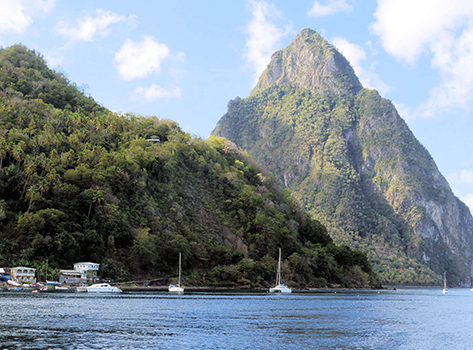 |
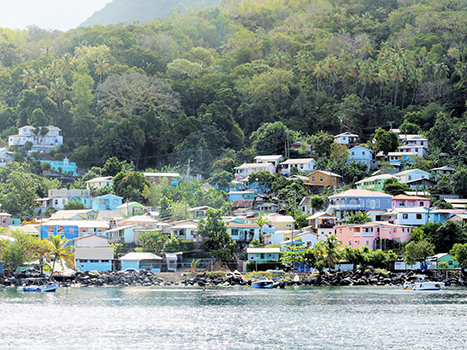 |
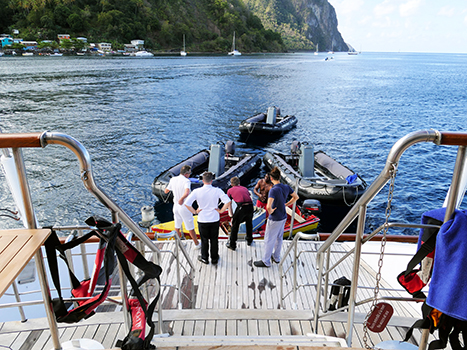 |
| Gros Piton | Soufriere | Getting ready to take people to the shore |
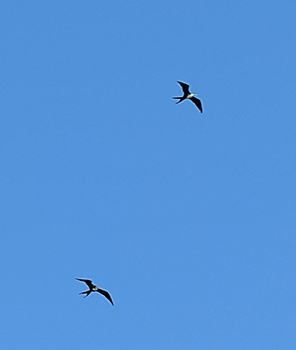 |
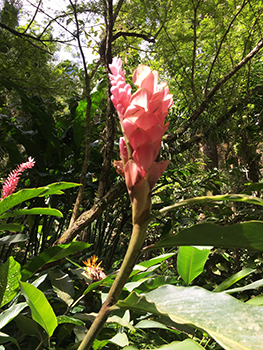
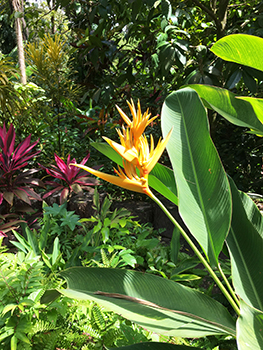
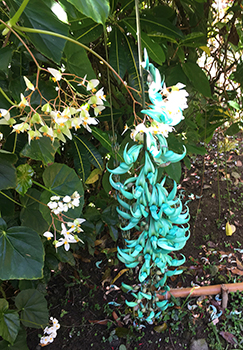
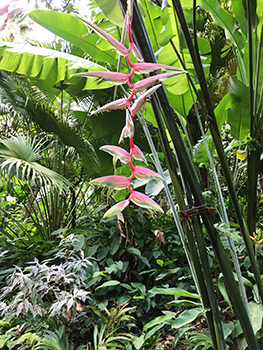
|
|
| Frigate birds | Exotic flowers | |
March 10, we were among the Tobago Cays. These are a sprinkling of uninhabited small islands with spectacular beaches, designated as a marine park. Spectacular or not, however, I was feeling miserable and so I stayed on the boat. I summoned the doctor; he said I had bronchitis, gave me some antibiotics and charged me $250.
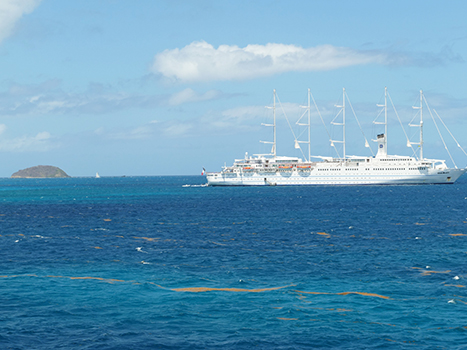 |
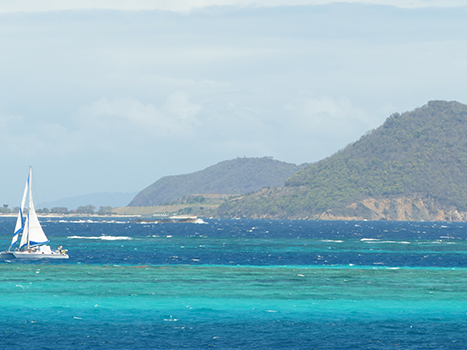 |
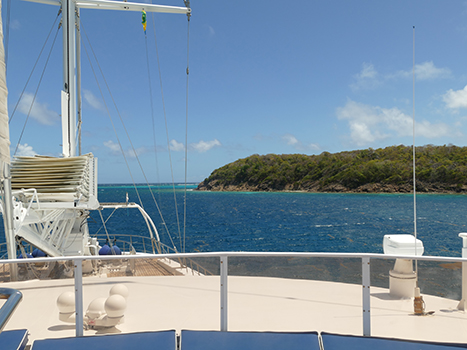 |
| Five masted cruise ship | Sundry cays | |
On March 11, we awoke in St Vincent and the Grenadines. The morning excursion was into Kingston, the capital. In the afternoon, I dragged myself out of bed for the excursion to Bequia. We saw a turtle hatchery, where the young turtles are protected from the many hazards of real life until they are old enough to fend for themselves (against the protests of Darwin). And we went to place where they crafted model ships, which were truly beautiful and which they would ship back to your home in the US if you wanted them to.
March 12 marked the end of the cruise as we sailed into Bridgetown, the capital of Barbados. Overall, I had mixed feelings about the cruise - the weather had been gorgeous, the islands fascinating, the boat very attractive, the fellow passengers interesting. On the other hand, I had been sick and miserable pretty much the whole time. By the end of the cruise, I was feeling a little better, presumably thanks to the antibiotics, but I still felt fatigued and was not interested in eating and the remaining two days we had scheduled in Barbados were more of the same. By the time I shook it off, I had lost 16 lbs - which of course I hastened to put back again.
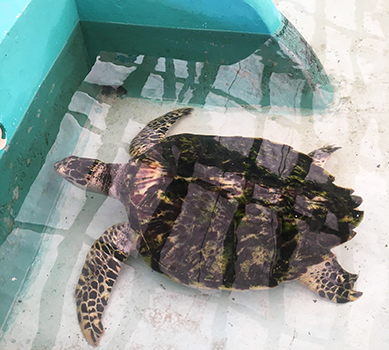 |
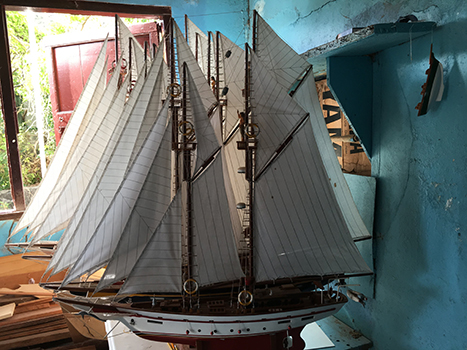 |
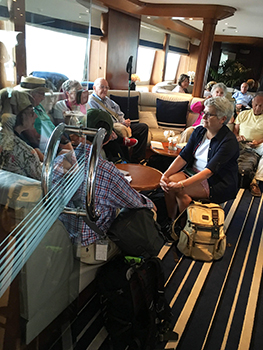 |
| Hawksbill turtle | Model sailboats | Waiting to desembark at Bridgetown |
Bridgetown is on the southwest corner of the island while the airport is an hour or so east of there. We had booked a hotel on the south coast, away from the fleshpots of the city and only ten minutes from the airport. One feature of the south coast where we were, however, turned out to be particularly fascinating - there is a large bay with reasonably calm water and a steady wind which is perfect for kiteboarding, a sport that I had not heard of before, let alone seen in action. It is kind of a cross between surfing and windsurfing. The board is smaller than a surfboard and the surfer's feet are fixed to it. The surfer then wears a harness, to which is attached a large controlable kite. The wind provides the power, so that the surfer doesn't have keep paddling out beyond the surf to start over. We watched them zooming across the bay and back, tacking like a small sailboat.
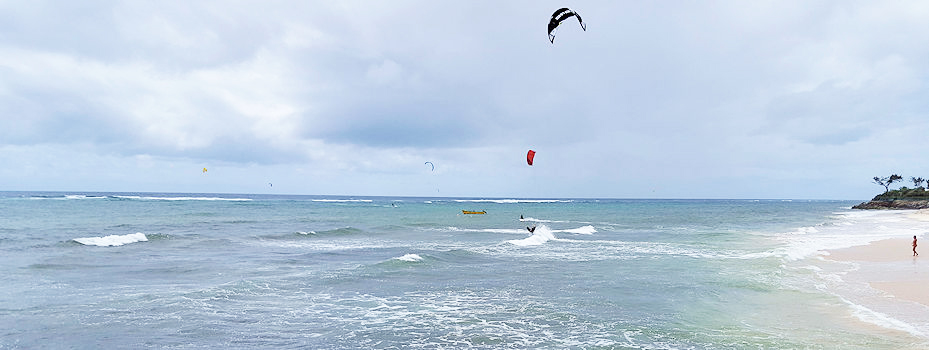 |
||
| Kites in the bay | ||
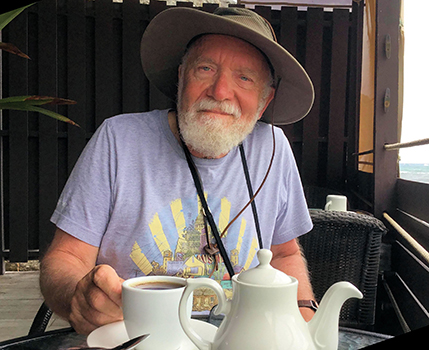 |
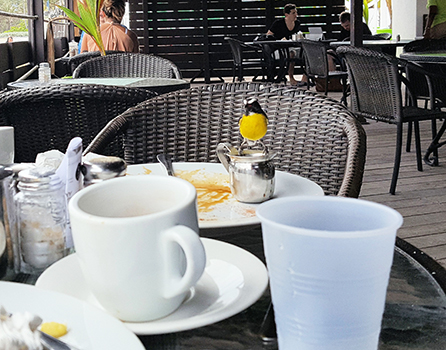 |
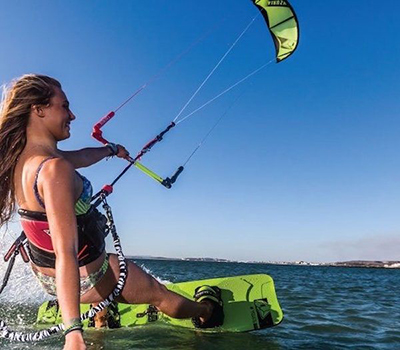 |
| Me looking sunburnt at the hotel cafe | Cheeky bird | How to do it (stock pic) |
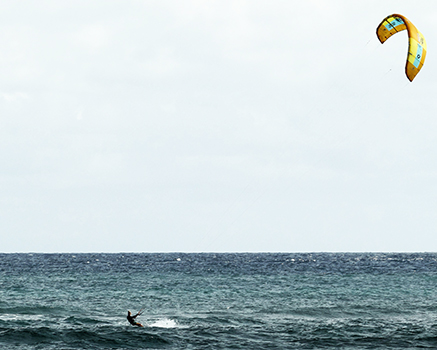 |
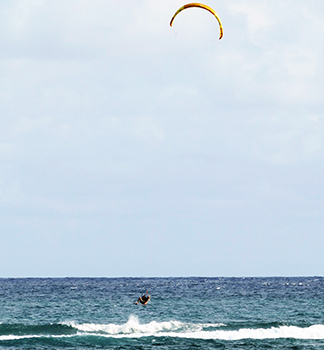 |
|
| Boarder | Boarder taking some air | |
And here's a brief video I took - at maximum zoom, so it is a little shaky.
Copyright © 2019 by Peter Lloyd-Davies. All rights reserved. Privacy Statement.